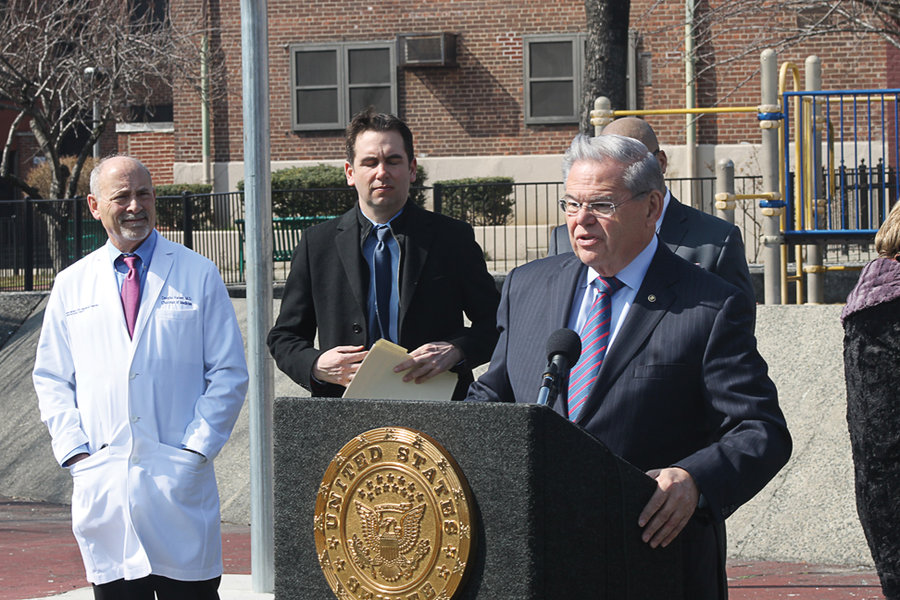Dr. Douglas Ratner of Jersey City Medical Center spoke at a press conference in the Booker T. Washington Houses courtyard in Jersey City on March 7 to support new legislation requiring the Department of Housing and Urban Development (HUD) to update its lead contamination regulations.
“There is no safe level of lead [in the human body],” said Dr. Ratner “Tests can’t tell you if the damage from lead is reversible.” But the lower the level of lead exposure, the better it will be for people – especially children, he said.
He was among about a dozen officials who met with the press to raise awareness about a problem that has a possible deadly affect on the poorest people in the state.
U.S. Sen. Robert Menendez (D–NJ) said children living in federally-subsidized housing are at risk of exposure, partly because of antiquated regulations by HUD, a federal agency that oversees housing projects as well as private property rented under federal Section 8 programs.
Jersey City has the most public housing projects in Hudson County, and Section 8 rentals are scattered through every municipality. Lead inspections are inadequate on older homes that typically used lead-based prior to a federal ban on lead imposed in 1978, Menendez said.
“No child should have to grow up in a home where simply breathing could hurt them.” – Sen. Robert Menendez.
____________
Children have been known to eat lead chips when playing in older structures, on porches, on stairwells, and other places.
While Jersey City has stepped up its inspections and the CDC has expanded the levels it considers dangerous, HUD is still using obsolete data for what are acceptable levels of lead, possibly putting kids in danger.
New legislation would require HUD to update its rules
Menendez unveiled legislation that would reduce the threat of lead exposure and lead poisoning in young children by requiring HUD to adapt more stringent definitions for the lead threat as well as adopt other measures.
More than 3,000 children in New Jersey are diagnosed each year with lead poisoning from exposure to lead paint and other sources in the home.
“No child should have to grow up in a home where simply breathing could hurt them,”
Menendez said. “We can’t sit idly by while millions of children in the country are suffering from the health effects of lead poisoning, and thousands more may be vulnerable to exposure.”
He said his bill will make sure that housing for the poor meets the most current standards set by the CDC.
The Lead-Safe Housing for Kids Act of 2016 requires HUD to align its definitions for lead poisoning with the Center for Disease Control (CDC).
The bill also requires new risk assessments to be conducted for low incoming housing constructed prior to 1978 before a family with a child under age six moves in.
Menendez said people should know there is a problem before the child is put at risk, when the consequence of lead poisoning could be irreversible.
Municipalities cannot act on their own
Jersey City Mayor Steven Fulop said Jersey City has been aggressive with its outreach on lead, hiring additional staff and increasing by more than 3,000 the number of children tested.
“This legislation will serve as another method of defense to ensure that young people are safe in their homes, and that federally-funded public housing is not overlooked,” Fulop said.
Fulop said the legislation is needed because the homes governed under Section 8 are private, and the city doesn’t have the authority to force owners to comply to higher standards that are set by HUD rules.
“Thousands of New Jersey’s children, primarily in low-income and minority neighborhoods, are poisoned by lead every year,” said Phyllis Salowe-Kaye, executive director of New Jersey Citizens Action. “Tragically, it is often the paint and dust in their homes, the place they should be safest, that is poisoning them.”
According to state Department of Health data released in 2014, there are more young children exposed to dangerous levels of lead in their homes in eleven municipalities and two counties in New Jersey than in all of Flint, Mich. That includes 5,128 children statewide reported with blood lead levels higher than the CDC’s standard and below the HUD required level.
The CDC reports that nationwide at least four million homes have children that are exposed to high levels of lead above the CDC danger levels.
Most of these kids are poor.
“We have a responsibility to protect children from lead poisoning , which is entirely preventable, but incurable condition,” said Staci Berge, president and chief executive officer of the Housing and Community Development Network of New Jersey.”
Serious developmental problems, sometimes death
Lead exposure can affect nearly every system in the body, but it often goes unrecognized because it can occur with no obvious symptoms. Children and pregnant women are at the greatest risk of lead poisoning. It can lead to anemia, weakness, kidney, braining damage, even death.
Menendez’s bill would require HUD to adopt CDC definitions for risk, as well as standards for soil dust and other tests. HUD would have to issue new rules for risk assessment for low income housing constructed before 1978 for hazards.
Tests would have to be done before the child moves in and must be more than just a visual inspection.
Studio apartments will not be exempt from inspections.
The law would allow families to relocate on an emergency basis without penalty or loss of assistance if a lead hazard is indentified in a home and a child is found to have low lead level in the blood.
Al Sullivan may be reached at asullivan@hudsonreporter.com.
